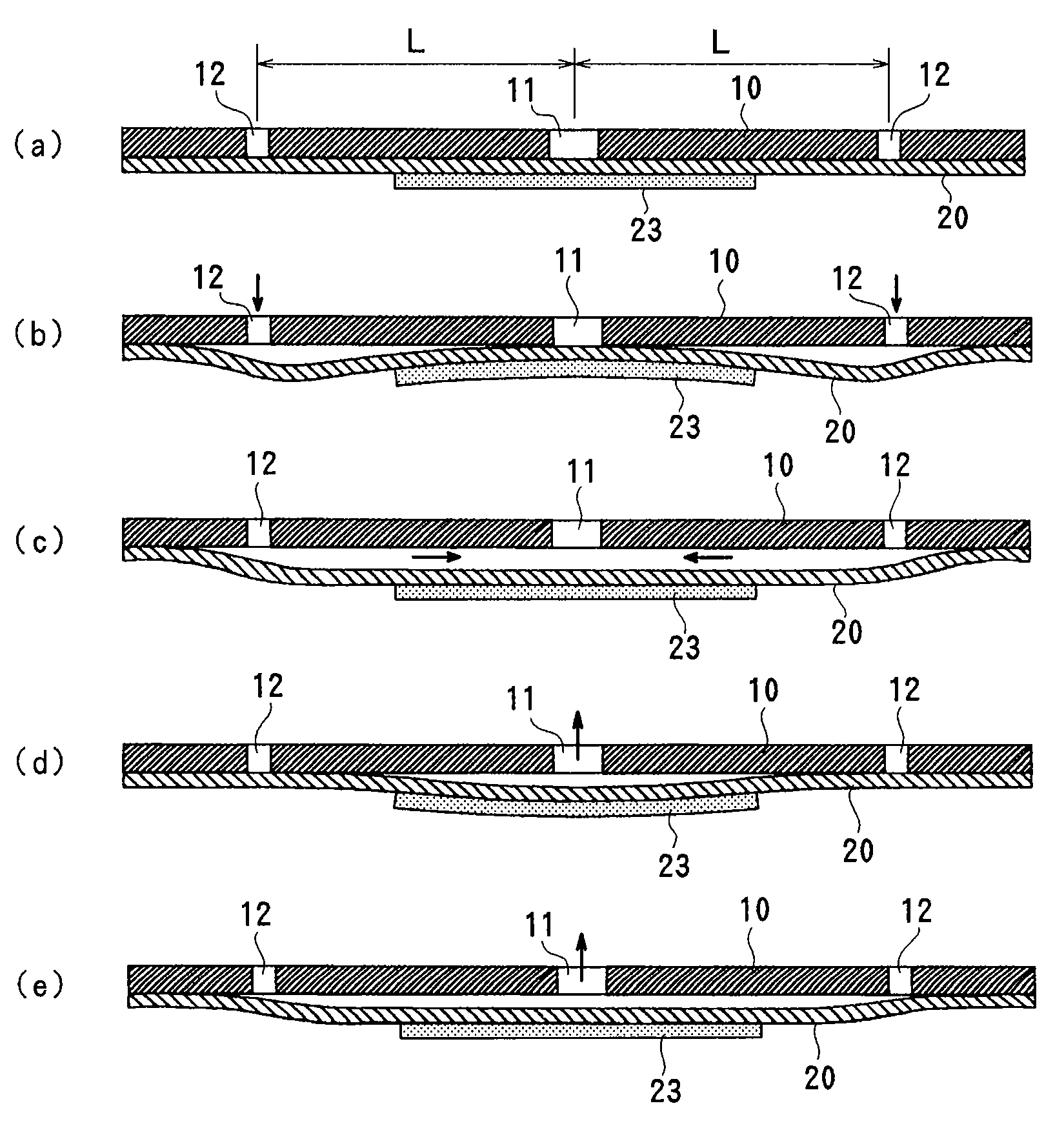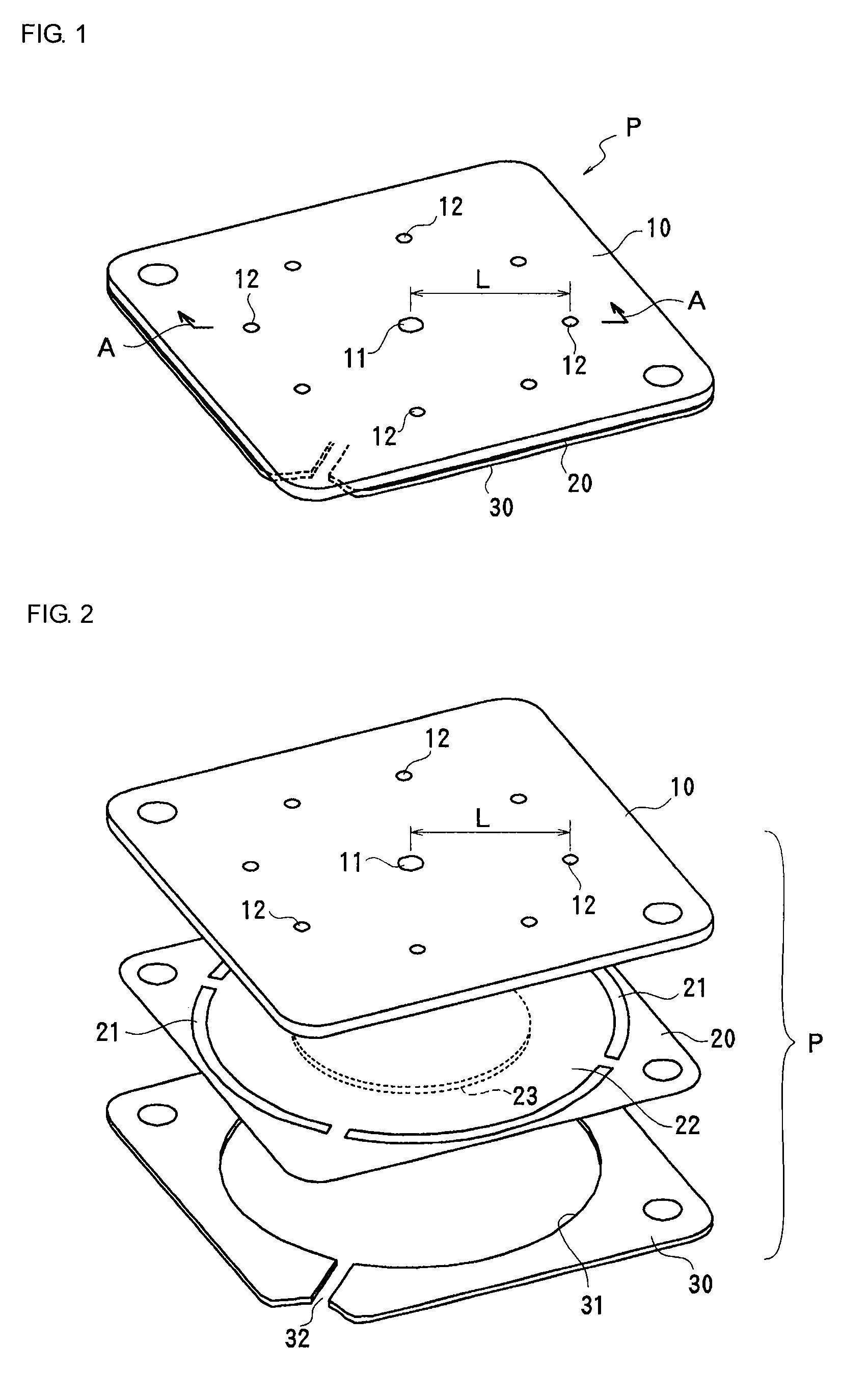Piezoelectric Pump
a technology of pump and piezoelectric pump, which is applied in the direction of pump parameter, positive displacement liquid engine, machine/engine, etc., can solve the problems of insufficient fluid transportation, inability to transport fluid, and reduced reliability of check valves, so as to achieve reliable discharge, efficient bent, and increased discharging pressure
- Summary
- Abstract
- Description
- Claims
- Application Information
AI Technical Summary
Benefits of technology
Problems solved by technology
Method used
Image
Examples
first embodiment
[0036]FIGS. 1 to 3 show a piezoelectric pump according to a first embodiment. FIG. 1 is a general perspective view of a piezoelectric pump according to the present invention, FIG. 2 is an exploded perspective view of the piezoelectric pump shown in FIG. 1, and FIG. 3 is a cross-sectional view, taken along line A-A in FIG. 1.
[0037]In this embodiment, a piezoelectric pump P has a structure in which a top plate 10 that forms a pump body, a diaphragm 20, and an annular presser plate 30 are stacked in order, and these stacked components are bonded together. The top plate 10 is shaped like a flat plate having rigidity. A first opening 11 is provided at the center of the top plate 10, and a plurality of second openings 12 are provided on the same circumference centered on the first opening 11. While eight second openings 12 are provided so as to ensure the flow rate herein, the number of second openings 12 can be arbitrarily set in accordance with the required flow rate.
[0038]The diaphragm...
second embodiment
[0053]FIG. 5 shows a pumping operation in a tertiary resonance mode according to a second embodiment of the present invention. The same components as those shown in FIG. 3 are denoted by the same reference numerals, and redundant descriptions thereof are omitted. While the second openings 12 are provided in the pump body 10 in the first embodiment, second openings 25 are provided in a diaphragm 20 in this embodiment. In this case, when driving is performed in a tertiary resonance mode, fluid can be drawn in from the second openings 25 on the back side of a piezoelectric pump and can be discharged from a first opening 11 on the front side. This structure is suitable for an air supply pump in a fuel cell or a cooling pump.
third embodiment
[0054]FIG. 6 shows a pumping operation in a tertiary resonance mode according to a third embodiment of the present invention. The same components as those shown in FIG. 3 are denoted by the same reference numerals, and redundant descriptions thereof are omitted. In this embodiment, a part of a pump body 10 extends outward from a diaphragm 20, and a second opening 16 shaped like a concave groove is provided on a lower side of an extending portion 15 so as to extend from an inner side of an outer peripheral portion to an outer side of the diaphragm 20. An inner edge of the second opening 16 is provided outside the outer periphery of a piezoelectric element 23 and inside a fixed outer peripheral portion of the diaphragm 20, and an outer edge thereof is open on the lower side from the extending portion 15. The second opening 16 does not always need to be shaped like a concave groove, and may be formed by a communicating hole that is open outside the piezoelectric element 23 and inside t...
PUM
 Login to View More
Login to View More Abstract
Description
Claims
Application Information
 Login to View More
Login to View More - R&D
- Intellectual Property
- Life Sciences
- Materials
- Tech Scout
- Unparalleled Data Quality
- Higher Quality Content
- 60% Fewer Hallucinations
Browse by: Latest US Patents, China's latest patents, Technical Efficacy Thesaurus, Application Domain, Technology Topic, Popular Technical Reports.
© 2025 PatSnap. All rights reserved.Legal|Privacy policy|Modern Slavery Act Transparency Statement|Sitemap|About US| Contact US: help@patsnap.com



